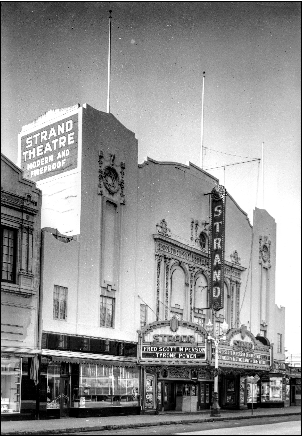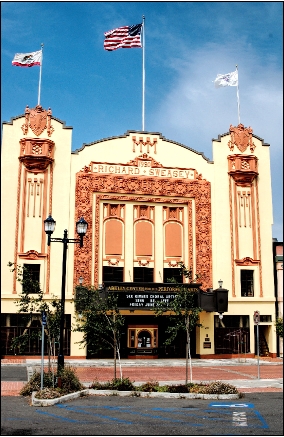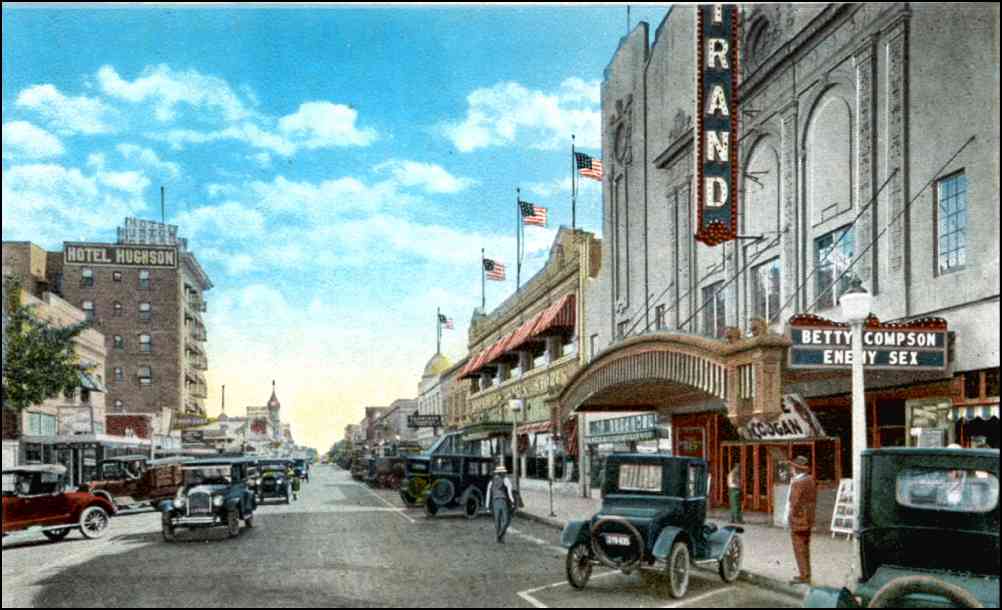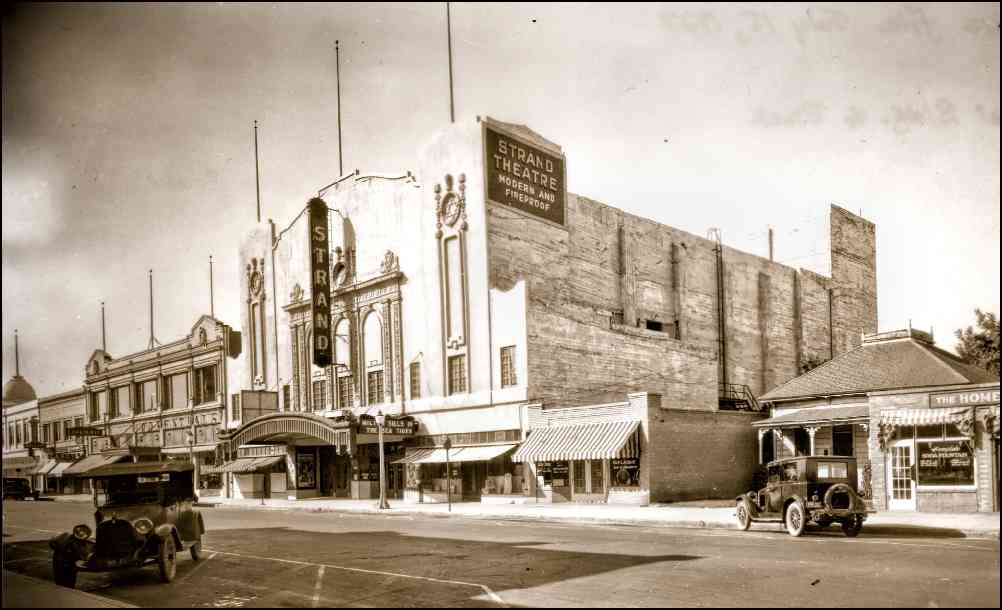THE STRAND (Opened in December, 1921; closed in 1971; destroyed by fire in July, 1984) Those who remember the Strand recall it as Modesto's grandest movie palace. Built in the era when movie theaters boasted crystal chandeliers and thick carpeting, this was the type of building that became a landmark in the community. The Strand was a full-fledged, 1,800 seat theater with a stage, orchestra pit, Wurlitzer organ, and a full complement of stage equipment. Built at a cost of $250,000 by a group of Fresno investors, the Strand "offered movies (first silent, then talking), live vaudeville shows, plays, operettas, and hosted graduations, music recitals and community programs," according to Modesto Then and Now by Colleen Stanley Bare. The large Wurlitzer pipe organ was played on weekends and to accompany silent films. For years, Modestans could point with pride to this "modern and fireproof" theater as it stood proudly in the downtown business core. When the Strand opened in 1921 the first film shown at the theatre was "The Mark of Zorro," starring Douglas Fairbanks. The two-day opening was attended by 3,500 people and the Modesto Evening News proclaimed it as "the greatest affair of its kind ever held in the history of Modesto. The Strand had thick carpeted floors, high ceilings, crystal chandeliers and wall murals in the lobby. It was advertised as the most elaborate and complete theatre in the San Joaquin Valley. It was sold to the National Theatre Syndicate in 1923. Sometime in the 1940s, the theater underwent an interior remodeling that stripped most of the early elements of design. The interior was streamlined and the lobby suddenly had a western theme, with a large mural of a wild west scene behind the snack bar. By the 60s, the theater was rundown and badly in need of work to refurbish it, which never happened. In 1971, the fire marshall closed the Strand for safety reasons. Years of neglect added to the overall decay of the structure and, in 1984, just as a group had been formed to look into restoring the theater, a fire of suspicious origin claimed the old structure. Some have claimed that, because the land on which the building stood was more valuable than the theater itself, the owner hired someone to start the fire, but no evidence, other than a few unsubstantiated claims, have ever materialized. Memories of the Strand My first recollection of attending a performance at the Strand comes from my childhood. I recall my parents taking me to see a show sponsored by the radio station, KTRB, which was located down the street from our house on Norwegian Avenue. The show was a live performance and, in my mind's eye, I see a singer on stage with a guitar and a microphone on a stand in front of him. Maybe country music in the early 1950s. Later, I would see "Gone With the Wind" for the first time at the Strand. By then, the balcony was closed (roped off with no admittance signs) and there were wooden 2x4 or 2x6 supports placed among the seats to hold up the balcony inside the theater. This was probably the late 50s or early 60s. I also recall the theater having no special outstanding design elements (other than the western mural in the lobby). The inside was a dark maroon color, with plain coverings on the walls. I would love to have someone share interior shots of the theater for this website. I know one exists of the "peacock" curtain when the theater opened, but have not been able to track it down. - Carl Baggese, Historic Modesto Webmaster | ||
The Strand - 10th Street Looking South The Strand Theater is shown at right in 1924 with its original marquee. The building to the left is Rosenthal's Department Store, later the site of Montgomery Ward. The Hotel Hughson rises on the left in the background. The film showing at The Strand is "The Enemy Sex" with Betty Compson. Point on the photo to see the poster for the 1924 silent film. |
The Strand - Full View of the Theater A full street view of the Strand is shown in this Baird Photography photo. The movie playing is "The Sea Tiger," which dates this photo to 1927. The sign at the top of the theater indicates that it is "Modern and Fireproof," a very important aspect of new theater construction following the devastating Iroquis Theater fire in Chicago in the early 1900s. Point on the photo to see the poster for "The Sea Tiger." |
The Strand's Twin Fully Restored in Eureka
The resemblance is obvious and the lineage is the same. Reid Brothers of San Francisco, James and Merrit Reid, architects and designers of the Cliff House and the Fairmont Hotel, designed and built both the Strand in Modesto and the State in Eureka. Built by Eureka businessman Richard Sweasey, whose name appears on the front,the State opened in December, 1920, a full year earlier than the Strand.
While the Strand never had a chance for a revival, the State, in all its Moorish Revival splendor, is now the Arkley Center for the Performing Arts, a slightly smaller theater than the Strand was. It is used on a continuing basis for performances, much as the Gallo Center for the Arts is used in Modesto.
Amazingly, a couple in Eureka, Bob and Cherie Arkley, purchased the theater for $2 million and refurbished it, restoring anything original that remained in the building. Long neglected and actually having been turned into a grocery store, the Arkley had traveled a long road back to be used again as it was originally intended.




